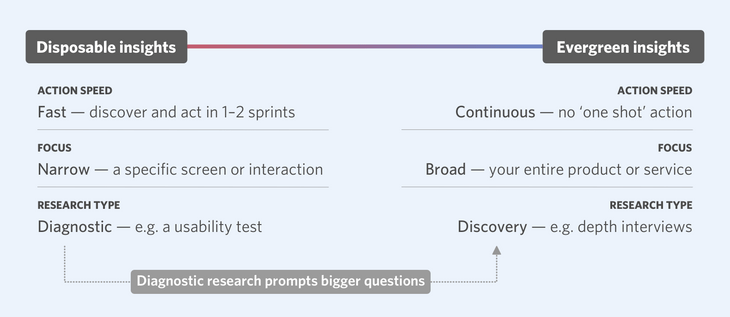Disposable insights
 Peter ParkesCo-founder
Peter ParkesCo-founder
Some insights are ‘evergreen’ – they’re relevant for a very long time. Those insights might teach you something about the fundamentals of how your customers or audience behaves, and they might end up becoming part of your design principles or brand values.
But sometimes the loop between research, insight and action is very tight – and the context of your insight changes so fast – that the insights you generate become irrelevant very quickly.
Think about usability testing and other forms of UX research, where you want to either validate an approach or diagnose a problem, and make changes as quickly as possible, perhaps in 1–2 sprints.
Once you’ve made those changes, some of the insights that led to the change become irrelevant.
For example, “users found step 2 of the checkout process confusing” becomes irrelevant when you’ve redesigned step 2 of the checkout process to make it less confusing.
Insights like this have a ‘to do’-like quality to them that means that once you’ve acted on them, you can safely delete them.
I like to call these disposable insights.
How do you know which insights are disposable?

First of all, not all insights you get from usability testing or other tactical forms of user research are disposable. As with any research activity, there will very often be halo insights – knowledge that you gain that you weren’t expecting to – and these might have more evergreen qualities.
However, the core insights from methods like usability testing are likely to be disposable. Let’s take the checkout example above to explore further.
Your web analytics tool shows that people keep dropping off at step 2 of the checkout process. You decide to run a remote, unmoderated test with 20 participants to dig a little deeper.
You discover that:
- users don’t understand the language used in form field labels
- the fact that the total price shown doesn’t include shipping costs is frustrating
- most users miss the T&Cs checkbox and so get an error the first time they try to proceed
Each of these insights has an implicit action:
- Improve the language used in form field labels
- Include shipping costs in the total shown on this screen
- Either remove the checkbox or make it more prominent
Once these actions are complete, those insights are ‘done’ too, and they can be deleted safely.
What’s the catch?
Those insights were defined in a very narrow context: step 2 of the checkout process. But did they also yield more strategic value? Almost certainly.
Let’s take a look at them again. Each of those narrow, tactical insights raises a bigger question:
- users don’t understand the language used in form field labels
→ what does this mean for the way we write interface copy generally? - the fact that the total price shown doesn’t include shipping costs is frustrating
→ do we need to review our approach to displaying prices across the site? - most users miss the T&Cs checkbox
→ how are we getting consent from our customers?
The bigger questions might already have answers, but might prompt you to do some more research. And the start of an answer to one of those questions might even lie in the research you’ve just done, even though it was tactical in scope.
So what do you do in this situation?
- Keep track of the ‘to do’ state of your tactical insights.
- Make sure you delete the tactical, disposable insights once they’re done. If you let them linger around, they’ll almost inevitably end up confusing people.
- Figure out a process for joining the dots between the discoveries you make in tactical research and those bigger questions. This might be something you do during synthesis, tying tactical insights to broader themes, or it might be something you do afterwards, once you’ve added those tactical insights to your research repository.
Whatever you do, just remember the most important thing: delete those disposable insights before they start causing problems.